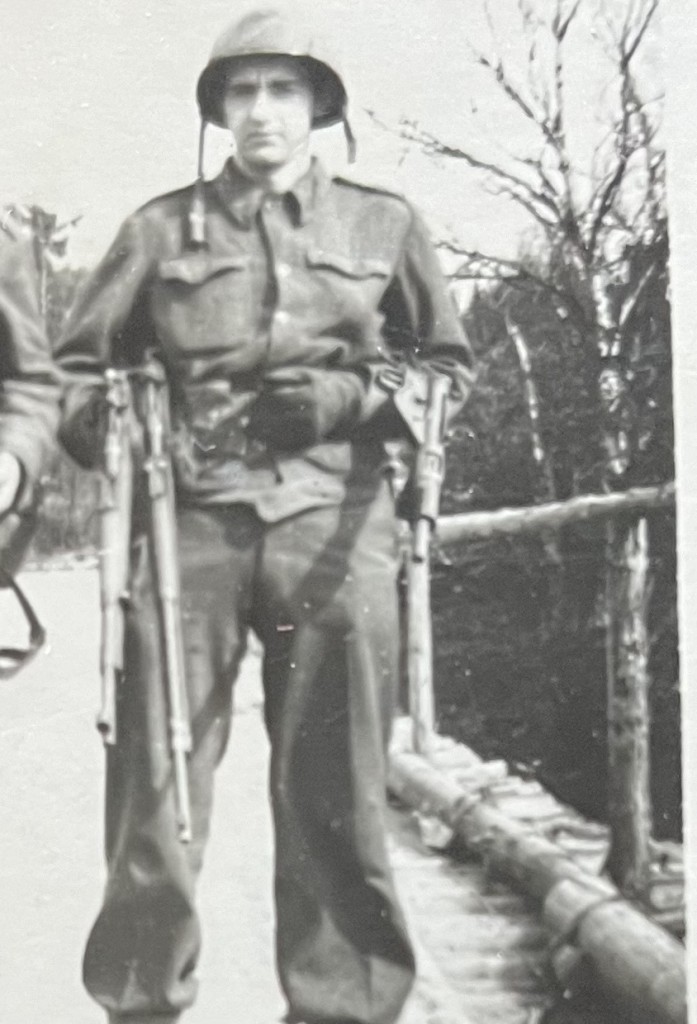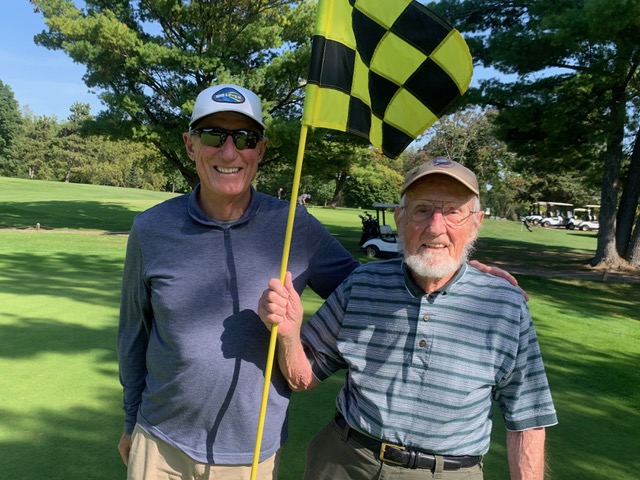In honor of Veterans Day, let me introduce you to Clarence Schipper, who served in the Army during WWII and still plays golf today at age 100. I’ll get to his golf game in a moment.
A native of Grand Rapids, Clarence (he insisted on me using his first name and not “Mr. Schipper”) was drafted out of high school and assigned to a secret radar unit for the Army Air Corps.
“It was a microwave early warning system developed by MIT (Massachusetts Institute of Technology), and it was the most advanced system in the world. Nothing could block it.”
He was stationed first in England shortly after D-Day and later in France and Germany on the Allied front. Clarence spent most of his time looking for enemy planes in front of the radar screen. He and his unit would spend four hours daily, the prescribed limit due to eye fatigue, peering at the screen. If planes appeared, their height, speed, and direction were recorded. This information was then relayed to American fighter squadrons. They worked as a team.
“We were credited with downing 526 enemy planes and damaging another 220,” said Clarence, who endured six major battles, including the famed Battle of the Bulge.
After the defeat of Nazi Germany, his unit waited to be transferred to the Pacific theater of the war, but Japan surrendered. When the war ended, he returned to Grand Rapids in October 1945, where he struggled to transition to civilian life.
“It took me more than a year to get back to normal. The war was still in my head. Today, doctors would say I suffered from PTSD (post-traumatic stress disorder.)”
He was hired by Keeler Brass Co., where he became an apprentice in the tool and die trade.
“I made 45 cents an hour, which was bumped up by another 10 cents after they learned I was a veteran.” It took him ten years to become a journeyman as a tool and die tradesman. He spent “42 happy years” at Keeler Brass when he retired in 1987. “I enjoyed working there; it was fulfilling and challenging.”
Before retiring, Clarence’s first serious encounter with golf was during a spring break trip to Kentucky in 1972.
“I didn’t know much about the game. When I picked up the golf bag I even carried it the wrong way,” he remembered, laughing.
His son Gary, who learned the game as a caddy at Cascade Hills Country Club in Grand Rapids and maintains a low index today, helped him with basic instruction. “Initially, I wanted to swing the club like a baseball bat. What a mistake! But Gary helped me with my swing.”
More than 50 years after those rounds in Kentucky, Clarence is still playing but no longer “swinging for the fences.” After walking and pulling a cart for years, even in his 80s, he still plays nine holes riding in a cart at least once a month with Gary. He shot a 49 at Maple Hill GC in Grandville two weeks ago. His best nine-hole score is a 41 at The Pines GC in Byron Center, where the staff continues to marvel at his game and longevity.
When asked, Clarence says the best part of his game is his putting despite losing vision in one eye in 1986. “Maybe because I worked with my hands my whole career, I’ve been a good putter.”
Last month, I watched Clarence at The Pines finish playing nine holes with Gary, a frequent golf partner of mine at Kaufman GC in Wyoming. Clarence was a stealth centenarian, carrying himself with an erect, sound posture and a steady gait. A stranger would never guess his age. His demeanor was upbeat, cheerful and engaging with a ready smile. Trim and fit, he’s a walking definition of “spry,” thanks partly to maintaining a daily regimen of 35 sit-ups and 35 push-ups. He laughed heartily when I compared him to Gary Player, long known for personal fitness and calisthenics. “I used to do 50 per day!”
And yes, Clarence’s putting stroke was sound, prompting a bit of envy from this 70-year-old- plus whippersnapper.
For his excellent health and long life, he credits his beloved late wife, Betty, for insisting on a healthy and nutritious diet for the household, which included their two sons and two daughters. “As a registered nurse, Betty didn’t serve fatty or fried foods. We ate right and kept active.”
Unlike her husband when they first met, Betty was also an optimist. “She taught me to believe in myself and our future together.” With moist eyes, he said Betty passed away three years ago at age 94 and after 72 years of marriage.
A lasting legacy of the Schippers was their volunteer work following retirement with Wycliffe USA, an evangelical Christian nonprofit organization. Its primary purpose is to translate the Christian Bible into local and native languages and aid minority language development. “At first, we bought a motorhome and just wanted to escape the Michigan winter. We had a good time but something more meaningful was lacking.” They learned about Wycliffe and its need for volunteers at its retirement center for missionaries and operational headquarters near Tucson, AZ, and later at a satellite center in North Carolina.
“We did many tasks, from repairing furniture to making parts for ministry planes.” They spent 26 years making a difference, the essence of a purpose-driven life.
With a bedrock of faith, family and friends continuing to sustain him in his eleventh decade, Clarence finds joy in simple things, like a crisply struck chip or a holed putt while his son admiringly looks on.
Echoing a favorite devotion, “I give thanks for everything.”
photos by Terry Moore and Clarence Schipper


